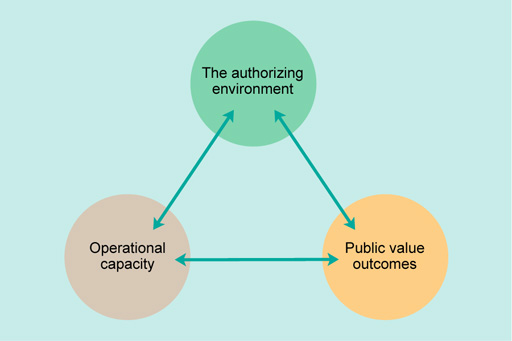2.1.2 A model of public value
In this excerpt from Public Value: Theory & Practice (Benington and Moore, 2011), the authors set out a practical tool for public leaders to use when they think about how they might bring about change to achieve public value. The tool is called the strategic triangle.
The strategic triangle of public value [shown above] is a framework for aligning three distinct but interdependent processes which are seen to be necessary for the creation of public value:
- defining public value – clarifying and specifying the strategic goals and public value outcomes which are aimed for in any given situation
- authorisation – creating the ‘authorising environment’ necessary to achieve the desired public value outcomes – building and sustaining a coalition of stakeholders from the public, private and third sectors (including but not restricted to elected politicians and appointed overseers) whose support is required to sustain the necessary strategic action
- building operational capacity – harnessing and mobilising the operational resources (finance, staff, skills, technology), both inside and outside the organisation, which are necessary to achieve the desired public value outcomes.
The strategic triangle thus suggests that strategies to create public value must satisfy three tests. First, they must aim convincingly at creating publicly valuable outcomes … . Second, they must mobilise sufficient authorisation and be politically sustainable – that is, gain ongoing support from key political and other stakeholders. Third, they must be operationally and administratively feasible … .
Each of these three factors is strategically important, but of course, they are rarely in alignment, and public leaders have to strive constantly to bring them into alignment and to negotiate workable trade-offs between them.

